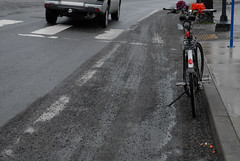
bike lanes are “safe and reasonable” to ride on.
(Photo © J. Maus/BikePortland)
Earlier this month, police officers in the City of Roseburg tried to strengthen their authority to ticket people who do not ride in bike lanes. They thought they could sneak an agenda item through City Council and be on their way. It turns out, they were wrong.
Officers wanted to close a loophole in ORS 814.420, the law that mandates people on bicycles must use a bike lane if/when one is available (there are myriad exceptions to the rule). Specifically, the police wanted to close the loophole that says a person is not required to follow the law, “unless the state or local authority… finds, after public hearing, that the bicycle lane or bicycle path is suitable for safe bicycle use at reasonable rates of speed.”
By police department request, City staffers provided Roseburg City Council with a list of all the bike lanes in Roseburg and the put it on the council agenda. The thinking was, if the list was passed, it would qualify as the “public hearing” required by law and would make it easier for Roseburg police to successfully prosecute people for riding outside the bike lane. The problem with that is, there would be no public process or qualitative analysis to make sure that those bike lanes were indeed “safe for bicycle use”.
I’m happy to report today that common sense has prevailed.
BikePortland reader and Roseburg resident Dick Dolgonas shared the following update about what happened:
“As you know, the City staff had proposed a hearing to allow officers to cite riders for not riding in bike lanes, with the exceptions noted in state law. Staff ended up taking the item off the agenda, but in the meantime local cyclists had been prepared, so they spoke to the City Council under audience participation.
Members of the Roseburg Bicycle/Pedestrian Coalition distributed photos of bike lanes which were inadequate, and spoke of the need to address safety issues. Others spoke of the need to promote cycling, including a member of the Umpqua Basin Economic Alliance who noted that being a bicycle-friendly city is key to attracting visitors and recreationists. He cited Portland, Eugene, Ashland, and Bend as examples of communities that fully embrace and promote safe bicycling, and commented that Roseburg should also follow their lead.
Another audience member spoke as a person without a car, and noted that bicycles are often used by lower income members of the community, and that any restrictions placed on biking could affect them to a greater degree.
What was frustrating for the Roseburg Bicycle/Pedestrian Coalition is that the City has made real progress in addressing our needs, and this action seemed not to serve any purpose related to safety. Additionally, we really have it pretty good down here as there are miles of well paved County roads, traffic is pretty light, and there are small stores located at convenient locations throughout the area. When we can lure people down here, they love it. In fact, we have found great success in attracting riders of all stripes with our upcoming Vineyard Tour on September 8 with 5 rides from 15 to 100 miles (more info at CycleUmpqua.com.
At the conclusion of the Council meeting, the mayor thanked those who spoke, and a council member indicated he agreed with the comments.”
So there you go. Proof positive that when people who care about — and understand — bicycling (and all of its benefits) make their voices heard, policies and ideas that hurt bicycling don’t stand a chance.
Way to go Roseburg! And thanks for sharing the update Dick. (I’ll have to stop for a ride on some of your gorgeous roads next time I visit my dad down in Grants Pass.)



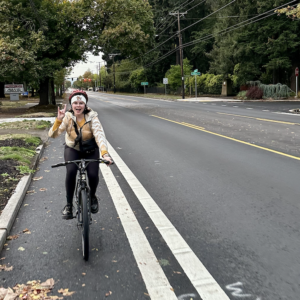
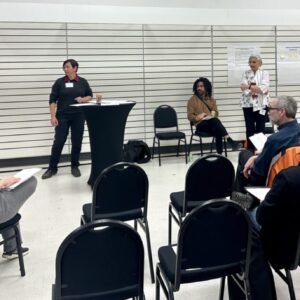
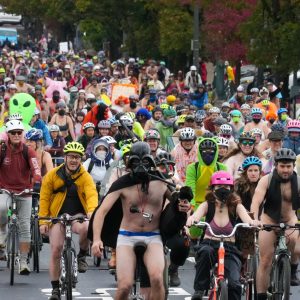
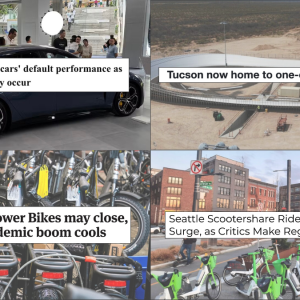
Thanks for reading.
BikePortland has served this community with independent community journalism since 2005. We rely on subscriptions from readers like you to survive. Your financial support is vital in keeping this valuable resource alive and well.
Please subscribe today to strengthen and expand our work.
This is fantastic news, I’m glad to hear it.
One question I have… is there any legislative change short of outright repeal that could improve this flawed law? Obviously repealing Mandatory Sidepath completely would be the best outcome in Salem, but what other ways could we make it less bad?
near as i can determine, the mandatory sidepath entered the statute in 1983. at the time, the public hearing requirement was the only “exception.” that exception was effectively eviscerated by the potter decision in 2002. the exceptions we actually rely on were added in 2005, thanks to BTA.
in order to do something effective with the public hearing “exception,” we would have to draft around potter, which says ORS 810.250(3) creates a [rebuttable] presumption that a traffic control device was properly placed. one way to do this would be head-on, adding language that says 810.250(3) does not create a presumption, rebuttable or otherwise, that a public hearing occurred sufficient to trigger 814.420(2). another, probably less effective, approach would be to specify what is required to rebut the presumption.
of course, i would rather simply repeal the mandatory sidepath law altogether, also making certain that localities would not be permitted to enact mandatory sidepath ordinances.
Cops, you gotta love them. Have them all rotate thru weeklong shifts on bikes (with glass-vulnerable street tires) and they would change their tune.
And what tune would that be?
Bikeportland’s stories about the city of Roseburg’s effort to be certain that streets within its city limits meet the requirements of ORS 814.420 (2), fail to recognize that officers may have had legitimate reasons cited in 814.420, except for (2), to believe a citation for 814.420 was warranted for instances they observed, of people traveling by bike and not using a bike lane.
If police officers in Roseburg are seeking…which I rather doubt… to issue citations to people that aren’t riding in a bike lane because it’s littered with rocks, glass, and other hazards, the city making an effort to be certain that bike lanes within its city limits meet (2) of the law would do absolutely nothing to help gain such an objective, because (3)(c) of the law provides the exception for hazards.
Readers here at bikeportland have not heard from police officers in Roseburg, the kind of example they observed, of people on bikes not using a bike lane, they believed represented a violation of ORS 814.420. Seems like we should probably hear what the police have to say about that before presuming they’re out to use 814.420 citations to punish people riding bikes.
That’s what Philadelphia does, and the police officer can’t volunteer or decline the duty.
This ought to be a minimum requirement for Platinum city like rating.
Great story.
Good job Dick and all the bikey folks in Roseburg. Keep making Roseburg a great place to ride, live, work, and play.
“…punitive police power grab” maus/bikeportland
Catchy phrase to use in this story’s headline, but according to facts that have been reported here in bikeportland stories, it does not seem to be true, that in seeking administrative clarification of ORS 814.420¹(2), the police in Roseburg attempted to ‘grab power to punish’.
The word ‘punitive’ means ‘Inflicting punishment’.
Recalling from memory what bikeportland stories reported…a Roseburg police officer felt he had seen occasions where a citation for ORS 814.420 ‘Failure to use bicycle lane or path’ was called for, but being aware of the requirement that (2) of that law called for, and not knowing for certain whether bike lanes and paths within Roseburg city limits met this requirement, did not feel he could be certain of writing a valid citation for ORS 814.420 ‘Failure to use bicycle lane or path’.
Leading up to this Roseburg city council action, has there been any report of Roseburg police using ORS 814.420 ‘Failure to use bicycle lane or path to punish people that travel by bike in that town’? None whatsoever that I recall reading.
By the way…did anyone…in Roseburg or elsewhere, ever actually find out whether any of the bike lanes and paths within that city’s limits met the public hearing for safe use requirement?
quote from the story you just read (if you read it):
“Members of the Roseburg Bicycle/Pedestrian Coalition distributed photos of bike lanes which were inadequate, and spoke of the need to address safety issues.”
ticketing someone with a class D traffic violation is a punishment, however mild in the scale of whatever you are measuring it against.
asking the city council to simply declare all bike lanes in town compliant with the public hearing requirement without, y’know, a public hearing on each bike lane is kinda grabby.
In those spots where the bike lane is too bad to ride in they should just get rid of the stripe altogether.
“…too bad to ride in…” jim
What do you mean by ‘too bad to ride in’? Some bike lanes that have been created, aren’t particularly practical or safe to ride in because they’re too narrow for travel above a certain speed, or for passing other people either on foot or bike that are traveling more slowly.
I’ve semi-seriously seriously looked for a standard by which cities and towns around the country design and construct bike lanes to provide a certain level of safe travel use. Didn’t run across any such standard so far. In a Beaverton civic plan land use transportation strategies document, is the following remarks:
“…Bike lanes should be
between 5 – 6 feet minimum, the latter being the preferred width when striped along on-street parking in order to mitigate conflicts with car doors. The City of Beaverton’s bike lane width standard is five feet. …”
Design…and construction, is what I figure (2) of 814.420 relates to. For bike lanes, specs should include lane width and the speed the bike lane is sufficient for, just as is done with main lanes of roadways. Beaverton providing 5′ for a bike lane, isn’t bad, but considering that main lane width is generally 10′-12′ width, 5′ isn’t great for bike travel at speeds over…I’ll say 12mph.
I believe this is the type of thing a police officer questioning whether someone traveling on a bike outside of an available bike lane would have to consider in deciding whether or not a citation for 814.420 was warranted.
That’s a good point that there is no set standard for how wide a bike lane needs to be. Perhaps if there is not enough room for a 5 ft bike lane there should just be a 4 inch fog line painted, then cars would stay somewhat to the left, bikes can be in the lane or if they want to brave the narrow pavement to the right they can.
Does the MUTCD not provide design standards for bike lanes?
No, that’s a different agency. The current standards are kept by NACTO and AASHTO, and there is some conflict between the standards as AASHTO is primarily to get cyclist out of the way of drivers and NACTO is to provide a safe place for cyclists. Slightly different goals with greatly different results.
One thing that seems to be ignored in this is that a bike lane can change from one minute to the next from safe and serene to a trash and debris choked nightmare. The lanes could be certified as safe today and be totally unusable tomorrow. Just look at that picture at the top of the article of the bike lane filled with loose gravel, that can happen overnight given a heavy rain and a source of gravel.
“One thing that seems to be ignored in this is that a bike lane can change from one minute to the next from safe and serene to a trash and debris choked nightmare. …” Opus the Poet
In this discussion, day to day changing bike lane condition aren’t being ignored, or at least, I don’t think think they are. Those are valid reasons for riding outside a bike lane, and are addressed by (3)(c) of the law, as I mentioned in an earlier comment.
At this point, I’m just guessing, but I don’t think (2) of the law relates to road debris and so on, but probably instead to design specs. I did finally decide this morning to send off an inquiry about this question to someone working with city where I live, Beaverton. Not exactly optimistic that I’ll get an answer, but we’ll see. Might be next week before/if I get a response.